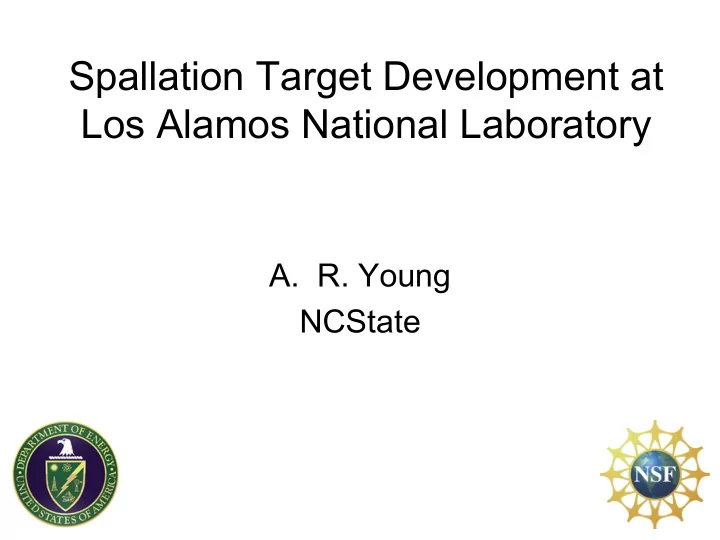

Spallation Target Development at Los Alamos National Laboratory A. R. Young NCState
The LANSCE beam: 800 MeV, ~100 μ A proton beam • Beam produced in 620 μ s “macropulses” • Macropulse composed of micropulses of ~8×10 10 protons Beam delivered to experimental areas can be adjusted to intermittent delivery with from 1 micropulse to full macropulse in beam Proton Storage Ring (Lujan center and also possibly Target 2, the “blue room”) creates single 250 ns pulses with 4×10 13 protons, delivered at up to 120 Hz
LANSCE Facilities: What can be done? • Lujan Center: neutron scattering studies - Reflectometer is used to evaluate reflectivity of guide materials • Target 2 ( Blue Room ) : general spallation target developm ent at low pow er - Direct measurements of performance of moderator materials and geometries • Area B: ultracold neutron ( UCN) source and technology developm ent - Explore properties of solid deuterium UCN/ VCN source - Develop UCN/ VCN technologies (guides and detectors)
Target 2 (Blue Room) • Maximum parameters: 100 Hz, 80 nA (~65 W) • Energy adjustable from 200 MeV to 800 MeV • PSR pulses also can be used Useful characteristics: • Space: 40 ft diameter dome • Al floor raised 20 ft above concrete “basement” to reduce particle “return” signals • proton beam focusing elements available to adjust spatial profile of beam • timing substructure available
What has been done: Mark III development (Guenter’s talk)
TOF studies of cold and ultracold neutron production from solid deuterium
What Can Be Done? • Direct evaluation of neutron moderation performance (neutron flux) of “inverted source” geometry or other target geometries • Direct evaluation of heating effects for model geometries Examples: Blue room and related tests uncovered critical materials issues for Mark III source Blue room and related tests uncovered serious issues for UCNA source: Beam-generated heading and vapor production in source material UCN losses due to use of cold windows in transport system Losses due to para-deuterium
Layout in Area B 800 MeV protons UCN Source Superconducting Spectrometer (SCS)
UCNA Experimental Layout in Area B of LANSCE 2 UCN Test beam ports Polarized or unpolarized UCN Cryogenics: flowing LN 2 and LHe 1T Spectrometer 2 liquifiers with about 100 l/hr capability Floor space: 75’ x 75’ (with mezzanine) Ceiling: 29’ Crane access 7T Polarizer magnet with AFP spin-flipper Test beam port 6T Pre-polarizer magnet/Zr foil assembly Cryogenic plant SD 2 source Test beam port Biological Shield
Loading the Decay Volume: SD 2 source facility 4 kW spallation power (about 5 μ A) • 2005: no decays replaced horizontal guides w/ SS • 2006: 2 s -1 (raw rate) To Gate Valve current: <1 μ A → 2 μ A, improved flapper • 2007: 6 s -1 current: → 4 μ A, source volume 2l • 2008: 15 s -1 guides changed to DLC-coated EP Cu, geom C • 2009: 30 s -1 new target and improved guides before AFP • 2010: 55 s -1 (Nov) ≈ 80 UCN/ cm 3 at guide wall 2 UCN/ cm 3 in decay trap! Solid deuterium source
What Can Be Done? • Direct evaluation of UCN and VCN production in solid and liquid deuterium sources (UCNA source can serve as benchmark and test of methods) • Development and evaluation of neutron detection and neutron optics Examples: 1) Multichambered 3He detectors developed for TOF studies of VCN production in UCNA source 2) Low noise MWPCs developed for UCN detection 3) DLC-coated UCN guide developed for polarization-preserving neutron transport
Higher Power Operation • Specific areas may be available for higher power operation – UCNA utilized Line B for this purpose during development work – Other sites appropriate for high power testing exist, but may require more beamline development • A dedicated high power target test station (HPTTS) with cryogenic capability is also under consideration for a future facility, which would provide an ideal development platform for next generation neutron sources…
Recommend
More recommend